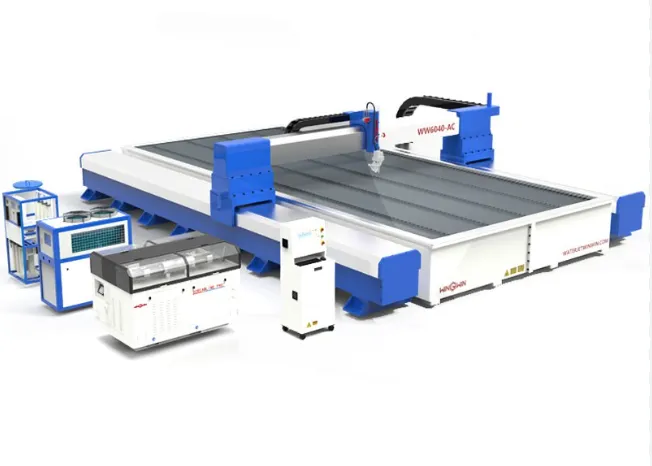The CNC laser cutting system features a rigid steel frame with thermally stabilized components to maintain geometric accuracy during operation. Heavy-duty linear guideways support the cutting head assembly across X-Y axes, while servo-driven ball screws ensure precise positioning. The machine bed incorporates a slat or honeycomb design for optimal material support and scrap removal, with load capacities ranging from 500kg to 5000kg depending on model size.
Laser Source Technology
Modern systems utilize three primary laser types:
- CO₂ lasers (100W-12kW) for non-metallic materials
- Fiber lasers (500W-20kW) for metal processing
- Disk lasers (1kW-8kW) for high-reflective materials
The resonator unit maintains stable beam quality with M² values typically between 1.1-2.0, while chiller systems regulate operating temperatures within ±0.5°C.
Motion Control System
Precision movement is achieved through:
- AC servo motors with 23-bit absolute encoders
- Linear scale feedback for closed-loop positioning
- Acceleration rates up to 2G
- Maximum travel speeds of 150m/min
- Positioning accuracy of ±0.03mm/m
- Repeatability within ±0.01mm
Cutting Head Assembly
The optical delivery system consists of:
- Collimation and focusing lenses
- Capacitive height sensors (0.01mm resolution)
- Automatic nozzle changers
- Beam path purging system
- Protective window monitoring
- Process gas delivery (up to 25bar)
- Integrated camera vision (optional)
Control System Architecture
The CNC platform incorporates:
- Industrial PC with multi-core processor
- Real-time operating system
- 19″ touchscreen HMI
- Ethernet Powerlink communication
- USB 3.0 and network interfaces
- Remote monitoring capability
- 1000-block look-ahead processing
Material Handling Systems
Automated options include:
- Sheet loaders (1.5mm-25mm thickness capacity)
- Pallet changers
- Conveyor belt systems
- Robot integration for part removal
- Stacking and sorting units
- Scrap removal conveyors
Cutting Process Parameters
Typical operating ranges:
- Cutting speeds: 0.5-50m/min (material dependent)
- Piercing times: 0.1-5 seconds
- Kerf widths: 0.1-1.0mm
- Focus positions: ±5mm adjustable
- Assist gases: O₂, N₂, compressed air
- Nozzle standoff: 0.5-3.0mm
Material Compatibility
Processable materials include:
- Mild steel (0.5-30mm)
- Stainless steel (0.5-25mm)
- Aluminum (0.5-20mm)
- Brass and copper (0.5-12mm)
- Plastics (acrylic, polycarbonate)
- Wood and engineered materials
Safety Systems
Comprehensive protection features:
- Class 1 laser enclosure
- Light curtain perimeter guards
- Emergency stop circuits
- Gas leak detection
- Fire suppression system
- Fume extraction monitoring
- Radiation sensors
Exhaust and Filtration
Environmental controls include:
- 10,000-50,000m³/h extraction capacity
- Multi-stage filtration (HEPA/activated carbon)
- Spark arrestor systems
- Noise reduction measures
- Heat recovery options (optional)
Software Ecosystem
Integrated programming solutions:
- CAD/CAM nesting software
- DXF/DWG import capability
- Common cutting database
- 3D simulation
- Production monitoring
- Maintenance scheduling
Precision Specifications
Manufacturer performance standards:
- Positioning accuracy: ±0.05mm/m
- Repeatability: ±0.02mm
- Angular accuracy: ±0.1°
- Hole roundness: 0.05mm TIR
- Cut edge perpendicularity: 0.01mm/mm
Electrical Requirements
Power consumption:
- Laser source: 10-150kVA
- Motion system: 5-30kVA
- Chiller unit: 3-15kVA
- Auxiliaries: 2-10kVA
- 3-phase 400V±10% power supply
Maintenance Protocols
Scheduled service includes:
- Daily optical path inspection
- Weekly lens cleaning
- Monthly guideway lubrication
- Quarterly resonator maintenance
- Annual system calibration
- 8,000-hour laser source service
Optional Features
Available upgrades:
- Automatic nozzle changer
- Tube cutting capability
- 3D cutting head
- Marking/engraving function
- Barcode reader
- Sheet thickness measurement
Industrial Applications
Common manufacturing uses:
- Automotive components
- Aerospace parts
- Electrical enclosures
- Architectural metalwork
- Signage and displays
- Industrial machinery
 Physical Dimensions
Physical Dimensions
Typical machine footprints:
- Compact models: 3m x 2m
- Production systems: 6m x 3m
- Large-format: 15m x 4m
- Weight ranges from 2,000kg to 40,000kg
Technological Advancements
Recent innovations include:
- AI-based parameter optimization
- Digital twin integration
- Hybrid laser/mechanical cutting
- Ultra-high-speed piercing
- Automated defect detection
- Cloud-based monitoring
Operator Interface
Control panel features:
- Multi-touch display
- Virtual keyboard
- Job queuing system
- Cut parameter library
- Maintenance alerts
- Production reports
Quality Assurance Systems
Integrated measurement:
- Cut edge monitoring
- Nozzle alignment check
- Beam quality analysis
- Material thickness verification
- Process documentation
Economic Considerations
Production factors:
- Cutting cost per meter
- Gas consumption rates
- Power efficiency
- Labor requirements
- Maintenance costs
- Throughput capacity








